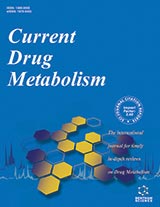摘要
三阴性乳腺癌(TNBC)是由雌激素受体(ER),孕激素受体(PR),和缺乏表达或扩增人表皮生长因子受体2(HER2)所定义的。TNBC的临床病理特点是高分级,高细胞增殖率和更大程度的染色体重排。三阴性乳腺癌患者更可能耐药并且治疗更加困难,并且还经常BRCA1突变。BRCA1基因启动子区的甲基化与减少BRCA1 mRNA水平相关。有BRCA1基因甲基化的TNBC患者与非甲基化的基因相比有更好的无病生存期。从治疗的角度来说,BRCA1基因的表达水平对不同类的化疗有着重要的决定因素。BRCA1功能性肿瘤对DNA损伤的化疗药物如铂类药物过敏。虽然铂类药物是目前广泛使用的在乳腺癌化疗中传统的化疗药物,但是他们的使用有几个缺点。因此,十分令人感兴趣的是可以寻求作为替代的治疗金属为基础的化合物,以克服这些铂类药物的局限性。钌基化合物可能是最有前途的替代铂类药物。本文综述了作为预测指标,以及抗癌钌化合物的一个潜在的药物靶标基因的使用。
关键词: BRCA1;三阴性乳腺癌(TNBC);钌配合物。
Current Cancer Drug Targets
Title:BRCA1-Associated Triple-Negative Breast Cancer and Potential Treatment for Ruthenium-Based Compounds
Volume: 16 Issue: 7
Author(s): Khwanjira Hongthong and Adisorn Ratanaphan
Affiliation:
关键词: BRCA1;三阴性乳腺癌(TNBC);钌配合物。
摘要: Triple-negative breast cancer (TNBC) is defined by the absence of expression of estrogen receptor (ER), progesterone receptor (PR), and a lack of overexpression or amplification of human epidermal growth factor receptor 2 (HER2). The clinicopathological characteristics of TNBC include a high grading, a high rate of cell proliferation and a greater degree of chromosomal rearrangement. Patients with triple-negative breast cancer are more likely to be drug resistant and more difficult to treat, and are also frequently BRCA1 mutants. Methylation of the BRCA1 promoter region is associated with a reduction of the BRCA1 mRNA level. TNBC patients with a methylated BRCA1 had a better disease-free survival compared with those with non-methylated BRCA1. From a therapeutic perspective, the expression level of BRCA1 has been a major determinant of the responses to different classes of chemotherapy. BRCA1-dysfunctional tumors are hypersensitive to DNA damaging chemotherapeutic agents like platinum drugs. Although platinum based drugs are currently widely used as conventional chemotherapeutic drugs in breast cancer chemotherapy, their use has several disadvantages. It is therefore of interest to seek out alternative therapeutic metal-based compounds that could overcome the limitations of these platinum based drugs. Ruthenium-based compounds could be the most promising alternative to the platinum drugs. This review highlights the use of BRCA1 as a predictive marker as well as for a potential drug target for anticancer ruthenium compounds.
Export Options
About this article
Cite this article as:
Khwanjira Hongthong and Adisorn Ratanaphan , BRCA1-Associated Triple-Negative Breast Cancer and Potential Treatment for Ruthenium-Based Compounds, Current Cancer Drug Targets 2016; 16 (7) . https://dx.doi.org/10.2174/1568009616666160203113957
| DOI https://dx.doi.org/10.2174/1568009616666160203113957 |
Print ISSN 1568-0096 |
| Publisher Name Bentham Science Publisher |
Online ISSN 1873-5576 |
Related Books
 54
54 2
2
- Author Guidelines
- Bentham Author Support Services (BASS)
- Graphical Abstracts
- Fabricating and Stating False Information
- Research Misconduct
- Post Publication Discussions and Corrections
- Publishing Ethics and Rectitude
- Increase Visibility of Your Article
- Archiving Policies
- Peer Review Workflow
- Order Your Article Before Print
- Promote Your Article
- Manuscript Transfer Facility
- Editorial Policies
- Allegations from Whistleblowers
Related Articles
-
Monitoring the Inflammatory Process by Surface Enhanced Nanoimaging Microscopy
Current Neurovascular Research Synthesis and in vitro Cytotoxicity Studies of Certain Novel Heterocycles Derived from Bis 1, 2, 4-Triazoles and their DNA Damage Studies
Medicinal Chemistry Resistance to Anti-VEGF Agents
Current Pharmaceutical Design Homocysteine and Cerebral Stroke in Developing Countries
Current Medicinal Chemistry Impact of Nutrients on the Functioning of Intestinal Goblet Cells: Health and Therapeutic Perspectives
Current Nutrition & Food Science The Pathophysiological Role of PEDF in Bone Diseases
Current Molecular Medicine Vitamin D and Non-coding RNAs: New Insights into the Regulation of Breast Cancer
Current Molecular Medicine Inhibition of Testosterone Aromatization by the Indole-3-carbinol Derivative CTet in CYP19A1-overexpressing MCF-7 Breast Cancer Cells
Anti-Cancer Agents in Medicinal Chemistry Role of Class II Nuclear Receptors in Liver Carcinogenesis
Anti-Cancer Agents in Medicinal Chemistry Phosphorylation-Specific Prolyl Isomerase Pin1 as a new Diagnostic and Therapeutic Target for Cancer
Current Cancer Drug Targets Design and Discovery of Novel Quinoxaline Derivatives as Dual DNA Intercalators and Topoisomerase II Inhibitors
Anti-Cancer Agents in Medicinal Chemistry Anti-Inflammatory Treatments for Chronic Diseases: A Review
Inflammation & Allergy - Drug Targets (Discontinued) Cathepsin D as a Promising Target for the Discovery of Novel Anticancer Agents
Current Cancer Drug Targets Indazole Derivatives: Promising Anti-tumor Agents
Anti-Cancer Agents in Medicinal Chemistry Anti-proliferative and Apoptosis Induction Activity of Rhizome Extracts of <i>Paris polyphylla</i> Smith on Oral Cancer Cell
Current Cancer Therapy Reviews Situating Nutri-Ethics at the Junction of Nutrigenomics and Nutriproteomics in Postgenomics Medicine
Current Pharmacogenomics and Personalized Medicine Antisense Treatment in Human Prostate Cancer and Melanoma
Current Cancer Drug Targets Approaches for Administering Chemotherapy in the Intensive Care Unit
Current Drug Safety Phage Displayed Biomolecules As Preventive and Therapeutic Agents
Current Pharmaceutical Biotechnology Approaching the Increasing Complexity of Non-small Cell Lung Cancer Taxonomy
Current Pharmaceutical Design


























